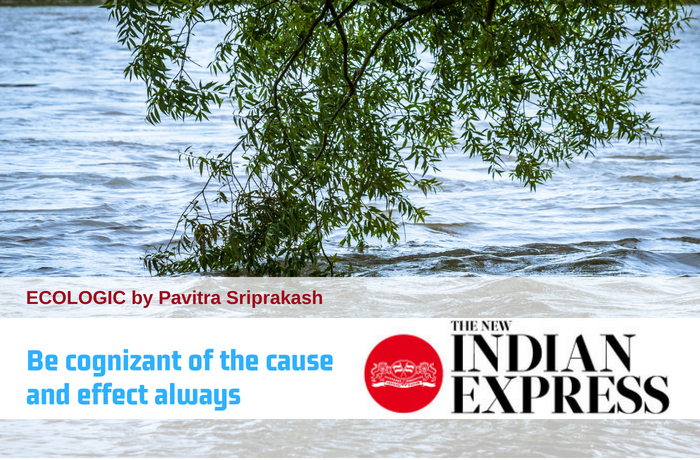01-Sep-2018: Pavitra Sriprakash, Director and Chief Designer, Shilpa Architects Planners Designers Pvt. Ltd. writes a weekly column on Sustainability for The New Indian Express titled “ECOLOGIC”. This week’s article highlights the “cause and effect” of our actions on this planet.
The Madhouse Effect, is a book by award-winning climate scientist Michael E Mann, and the Pulitzer Prize winning political cartoonist Tom Toles. According to one review, “it portrays the intellectual pretzels into which denialists must twist logic to explain away the clear evidence that human activity has changed Earth’s climate”.Both have fought relentlessly against climate denialism for most of their careers. While some overlook warning signs that links wanton human actions to catastrophic changes in climate, it is impossible to ignore anymore the hand of climate change on catastrophes like the recent floods in Kerala. It is an example of multiple failures caused by implementation of unsustainable development plans, and dubbed the Western Ghats’ worst flood in a century.
After a two-week bout of non-stop rain, Kerala has been left ravaged by floods with many millions in relief camps and unknown numbers dead; and worse, still trapped under old buildings where they were seeking refuge. While reports on Kerala have flooded the media, there is less talk of areas in Coorg in Karnataka where many have been rendered homeless or trapped due to the same rain system. Exacerbated by landslides in hilly terrain, flooding has led to the destruction of homes, bridges, road networks, and industries.
In an era of climate uncertainties that we have just entered, extreme rainfall events are going to become increasingly common. Uncontrolled growth at the expense of the environment will severely amplify the impact of climate change, and surely seems stupid to deny anymore. Our cities are simply not prepared for extreme weather events. In the case of Kerala as well, these events were predicted, and the possibility of such devastation was highlighted several years ago.
In 2011, the Western Ghats Ecology Expert Panel, chaired by the internationally-renowned ecologist Madhav Gadgil, submitted a report to the Indian Ministry of Environment and Forests. The report warned that an ill-thought focus on development was impacting the sustainability of the Western Ghats hill chain, one of the world’s most biodiverse areas that runs along the west coast of India. The expert report urged several states, including Karnataka and Kerala to adopt an approach of thoughtful conservation, and recommended the limiting of activities such as quarrying, and construction of dams near protected forests in hilly areas. The report was rejected by the Ministry as well as by both states.
Dismissing the warning signs, tens of thousands of trees were felled in Kodagu district of the Western Ghats in Karnataka in 2015 to construct high tension electric lines. Sand mining of river beds went unchecked and high-rise buildings were sanctioned on unstable hill slopes. These decisions have weakened the soil making it prone to landslides. The problem of course is much more complex.
Now urban and forest zones of Kerala and Karnataka are susceptible to flash floods, soil erosion, and even earthquakes. Should there be a chance to influence or vote on any development, irrespective of scale, be always cognizant of the cause and effect theory at play. We cannot be a party to the mindless drive to develop because there is a future cost to legate too.
Pavitra Sriprakash
Twitter @pavisriprakash
The writer is an architect, urban designer, dancer and chief designer at Shilpa Architects



